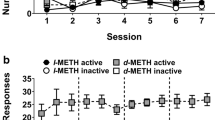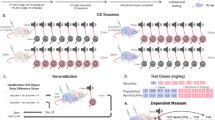Abstract
Morphine-amphetamine and morphine-naltrexone interactions were examined in three groups of White Carneaux pigeons (n=3), which were trained in a twochoice drug discrimination procedure under a FR-30 schedule of food reinforcement using 3.2 mg/kg morphine and saline as discriminative stimuli. Once stimulus control was acquired by these initial training stimuli, the training doses of morphine were gradually changed to 1.0 mg/kg for group A and to 10 mg/kg for group C. The three groups differed in the minimum dose required for stimulus control and the drugs to which the training stimulus generalized. Stimulus generalization to amphetamine was inversely related to training dose. Amphetamine potentiated the discriminative stimulus properties of morphine. Naltrexone blocked the discriminative stimulus properties of morphine to varying degrees, which appeared to be limited by the training dose and the rate-suppressing effects of naltrexone when administered alone. Challenging the morphine stimulus with amphetamine resulted in a qualitatively similar blockade. This blockade was a direct function of the morphine training dose. It is argued that MS-AMP interactions result in perceptual masking of the MS stimulus, which can be differentiated from pharmacological antagonism by NTX. Two other challenge drugs, ketamine, and sodium pentobarbital, did not alter stimulus control by morphine.
Similar content being viewed by others
References
Appel JB, Kuhn DM, White FJ (1978) Dual receptor mediation of the discriminative stimulus properties of pentazocine. In: Ho BT, Richards DW, Chute DL (eds) Drug discrimination and state-dependent learning. Academic Press, New York, pp 149–162
Barry III H (1974) Classification of drugs according to their discriminable effects in rats. Fed Proc 33:1814–1824
Browne RG (1981) Anxiolytics antagonize yohimbine's discriminative stimulus properties. Psychopharmacology 74:245–249
Browne RG, Weisman A (1981) Discriminative stimulus properties of delta-9-tetrahydrocannabinol: mechanistic studies. J Clin Pharm 21:227S-234S
Browne RG, Welch WM (1982) Stereoselective antagonism of phencyclidine's discriminative properties by adenosine receptor agonists. Science 217:1157–1159
Colpaert FC (1986) Drug discrimination: behavioral, pharmacological, and molecular mechanisms of discriminative drug effects. In: Goldberg SR, Stolerman IP (eds) Behavioral analysis of drug dependence. Academic Press, Orlando, pp 161–193
Colpaert FC, Janssen, PAJ (1982) Factors regulating drug cue sensitivity: Limits of discriminability and the role of progressively decreasing training dose in cocaine-saline discrimination. Neuropharmacology 21:1187–1194
Colpaert FC, Niemegeers CJE, Jannssen PAJ (1976) Fentanyl and apomorphine: asymmetrical generalization of discriminative stimulus properties. Neuropharmacology 15:541–545
Colpaert FC, Niemegeers CJE, Kuyps JJMC, Janssen PAJ (1977a) Narcotic cue and narcotic state: differential involvement of brain 5-hydroxytryptamine. Neuropharmacology 16:65–70
Colpaert FC, Niemegeers CJE, Janssen PAJ (1977b) Effects of alpha-methyl-p-tyrosine, adrenolytic compounds pimozide, and other neuroleptics on the narcotic cue. Arch Int Pharmacodyn 225:308–316
Colpaert FC, Niemeggers CJE, Janssen PAJ (1980) Factors regulating drug cue sensitivity: limits of discriminability and the role of a progressively decreasing training dose in fentanylsaline discrimination. J Pharmacol Exp Ther 213:474–480
Cooper JR, Bloom FE, Roth RH (1986) The biochemical basis of neuropharmacology. 5th edn. Oxford University Press, New York
D'Mello GD, Stolerman IP (1977) Comparison of the discriminative properties of cocaine and amphetamine in rats. Br J Pharmacol 61:415–422
France CP, Woods JH (1985a) Effects of morpine, naltrexone, and dextroorphan in untreated and morphine-treated pigeons. Psychopharmacology 85:377–382
France CP, Woods JH (1985b) Antagonism and rate-suppressing effects of opioid antagonists in the pigeon. J Pharmacol Exp Ther 235:442–447
France CP, Woods JH (1985c) Opiate agonist-antagonist, interactions: applications of a three-key drug discrimination procedure. J Pharmacol Exp Ther 234:81–89
France CP, Jacobsen, AE, Woods JH (1984) Discriminative stimulus effects of reversible and irreversible opitate agonists: morphine, oxymorphazone, and buprenorphine. J Pharmacol. Exp Ther 230:652–657
Gauvin DV, Young AM (1988) Perceptual masking of drug stimuli. Drug Dev Res (in press)
Gauvin DV, Young AM (1989) Effects of prior saline-morphine discrimination by pigeons on three-way discrimination including two morphine doses. Psychopharmacology 98:222–230
Gianutsos G, Lal H (1975) Effect of loperamide, haloperidol, and methadone in rats trained to discriminate morphine from saline. Psychopharmacology 41:267–270
Gianutsos G, Lal H (1976) Selective interaction of drugs with a discriminable stimulus associated with narcotic action. Life Sci 19:88–91
Herling S, Coale EH, Valentino RJ, Hein DW, Woods JH (1980) Narcotic discrimination in pigeons. J Pharmacol Exp Ther 214:139–146
Herling S, Valentino RJ, Solomon RF, Woods JH (1984) Narcotic discrimination in pigeons: antagonism by naltrexone. Eur J Pharmacol 105:137–142
Holtzman SG (1984) Discriminative stimulus properties of opioids that interact with mu, kappa, and PCP/sigma receptors. In: Seiden LS, Balster RL (eds) Behavioral pharmacology: the current status. Liss, New York, pp 131–147
Hunt DE, Lipton DS, Goldsmith D, Strug DL (1984) Street pharmacology: uses of heroin and cocaine in the treatment of addiction. Drug Alcohol Depend 13:375–387
Järbe TUC (1978) Discriminative stimulus properties of morphine in the pigeon. Pharmacol Biochem Behav 9:411–416
Jasinski DR, Preston KL (1986) Evaluation of mixtures of morphine and d-amphetamine for subjective and physiological effects. Drug Alcohol Depend 17:1–13
Kline FS, Young AM (1986) M. Differential modification of pentobarbital stimulus control by d-amphetamine and ethanol. Pharmacol Biochem Behav 25:1305–1313
Kolers PA (1983) Perception and representation. Annu Rev Psychol 34:129–166
Krimmer ED, McGuire MS, Barry III H (1984) Effects of training dose on generalization of morphine stimulus to clonidine. Pharmacol Biochem Behav 20:669–673
Lal H (1977) Drug-induced discriminable stimulus: past research and future perspectives. In: Lal H (ed) Discriminative stimulus properties of drugs. Plenum Press, New York, pp 207–231
Lal H, Gianutsos G, Miksic S (1977) Discriminable stimuli produced by analgesics. In: Lal H (ed) Discriminative stimulus properties of drugs. Plenum Press, New York, pp 23–45
Legge GE, Foley JM (1980) Contrast masking in human vision. J Opt Soc Am [A] 70:1458–1470
McCarten MD, Lal H (1979) Attenuation of the discriminative stimulus strength of morphine by haloperidol. Neuropharmacology 18:465–467
McMillan DE, Wolf PS, Carchman RA (1970) Antagonism of the behavioral effects of morphine and methadone by narcotic antagonists in the pigeon. J Pharmacol Exp Ther 175:443–458
Miksic S, Shearman G, Lal H (1978) Generalization study with some narcotic and nonnarcotic drugs in rats trained for morphine-saline discrimination. Psychopharmacology 60:103–104
Miksic S, Shearman GT, Lal H (1980) Differential enhancement of narcotic discrimination and analgesia by amphetamine and haloperidol: an evidence for distinct mechanisms underlying analgesia and euphoria. Subst Alcohol Actions/Misuse 1:281–285
O'Connel RJ (1985) Responses to pheronome blends in insect olfactory receptor neurons. J Comp Physiol 156:747–761
Overton DA (1974) Experminetal methods for the study of statedependent learning. Fed Proc 33:1800–1813
Overton DA (1979) Drug discrimination training with progressively lowered doses. Science 205:720–721
Overton DA (1984) State dependent learning and drug discrimination. In: Iverson LL, Iverson SD, Snyder SH (eds) Handbook of psychopharmacology, vol. 18. Plenum Press, New York, pp 59–127
Overton DA (1987) Applications and limitations of the drug discrimination method for the study of drug abuse. In: Bozarth MA (ed) Methods of assessing the reinforcing properties of abused drugs. Springer, New York Berlin Heidelberg Tokyo, pp 291–340
Rosecrans JA, Goodloe MH, Bennett GJ, Hirschhorn ID (1973) Morphine as a discriminative cue: effects of amine depletors and nalaxone. Eur J Pharmacol 21:252–256
Shannon HE, Holtzman SG (1979) Morphine training dose: a determinant of stimulus generalization to narcotic antagonists in the rat. Psychopharmacology 61:239–244
Sperling G (1965) Temporal and spatial visual masking. I. Masking by impulse flashes. J Opt Soc Am 55:541–559
Strug DL, Hunt DE, Goldsmith DS, Lipton DS, Spunt B (1985) Patterns of cocaine usage among methadone clients. Int J Addict 20:1163–1175
Swedberg MDB, Järbe TUC (1982) Morphine, cue saliency: limits of discriminability and third state perception by pigeons. In: Colpaert FC, Slangen JL (eds) Drug discrimination: applications in CNS pharmacology. Elsevier Biomedical Press, Amsterdam, pp 147–164
Tallerida RJ, Jacob LS (1979) The dose-response relation in pharmacology. Springer, New York Berlin Heidelberg
Valentino RJ, Herling S, Woods JH (1981) The relationship between the acute effects of narcotic antagonists and the narcoticdependent state. Psychopharmacol Bull 17:51–54
Wegel RL, Lane CE (1924) The auditory masking of one pure tone by another and it probable relation to the dynamics of the inner ear. Physiol Rev (Ser 2) 23:266–285
White FJ, Appel JB (1982) Training dose as a factor in LSD-saline discrimination. Psychopharmacology 76:20–25
White JM, Holtzman SG (1982) Properties of pentazocine as a discriminative stimulus in the squirrel monkey. J Pharmacol Exp Ther 233:396–401
Woods JH, France CP, Bertalmio, AJ, Gmerek DE, Winger G (1984) Behavioral assessment of insurmountable narcotic agonists and antagonists. In: Seiden LS, Balster RL (eds) Behavioral pharmacology: the current status. Liss, New York, pp 75–92
Young AM, Woods JH (1982) Limitations on the antagonistic actions of opioid antagonists. Fed Proc 41:2333–2338
Zwislocki JJ (1978) Masking: experimental and theoretical aspects of simultaneous, forward, and central masking. In: Carterette EC, Friedman MP (eds) Handbook of perception, IV. Academic Press, Inc., New York, pp 283–334
Author information
Authors and Affiliations
Rights and permissions
About this article
Cite this article
Gauvin, D.V., Young, A.M. Evidence for perceptual masking of the discriminative morphine stimulus. Psychopharmacology 98, 212–221 (1989). https://doi.org/10.1007/BF00444694
Received:
Accepted:
Issue Date:
DOI: https://doi.org/10.1007/BF00444694




